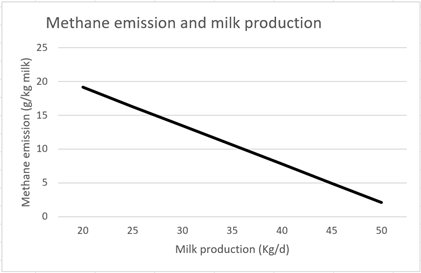10 January 2022 – The digestive system of livestock animals has become a key focus in animal agriculture to help realise the industry’s sustainability initiatives. The more efficiently this system functions in an animal, the more effectively it can convert feed into animal products. This, in turn, can translate into less resource intensive production and lower wastage, which are both key sustainability objectives.
For ruminant farmers, the road to improving the digestion of feed and feed ingredients in these animals means navigating the complexities of the rumen and its microbiome. By establishing a favourable environment here for beneficial microorganisms, the breaking down of feed into essential nutrients, like proteins, vitamins, and minerals, can be improved and help better animal performance, growth, and immunity.
According to today’s Industry Perspectives contributor, Prosol, live yeasts can play an important role in this process. The Italian nutritional ingredients producer’s Emanuela Epis, Product Manager for Biosprint, the company’s live yeast product, and Paolo Carcano, Technical Product Manager, sat down with Feedinfo recently to talk us through how Biosprint can foster rumen integrity and create the optimal microbiome conditions that can lead to efficiencies in feed conversion in ruminants. We also looked into how this can help further farmers’ economic objectives and sustainability initiatives, especially concerning methane emissions, plus address the question of live yeast dosage and its impact on animal performance and health.
[Feedinfo] Let’s kick off with why specifically live yeasts. What exactly are the effects that they can have on the rumen environment that make them more preferrable here compared to other yeasts?
|
Paolo Carcano |
[Paolo Carcano] Yeasts are eukaryotic, single-celled microorganisms, facultative anaerobes. This means that they can grow with and without oxygen. This is in opposition to rumen beneficial microorganisms that are strictly anaerobes. During ingestion and rumination, as well as from capillaries through the mucosal lining, it has been calculated that more than 20 litres of oxygen can enter daily into the rumen. Live yeasts can consume this extra oxygen, thus creating a favourable rumen environment for the rumen beneficial anaerobic autochthonous microbiota. |
Live yeasts are also able to stabilise rumen pH. Live S. cerevisiae yeast is able to grow faster than S. Bovis bacteria when competing for the utilisation of sugars, which can help limit the amount of lactate produced in the rumen.
Moreover, live yeast has been observed to stimulate the growth and metabolism of lactate-utilising bacteria, such as M. elsdenii and S. ruminantium, by supplying nutrients essential for these bacteria. These activities create a rumen environment optimised for cellulolytic bacteria, increasing efficiency and optimising digestion of the feed.
Now, if we look at deactivated yeasts, they are able to universally nourish all the rumen bacteria but have no ability to consume oxygen or stabilise rumen pH. They boost bacteria metabolism and, consequently, gas production, so are able to stimulate rumen microorganisms but without improving rumen environment, leading to an increased acidosis risk.
In an ex vivo laboratory simulation test that we performed in 2021 in cooperation with an external research lab, we observed that dead yeasts increased total gas and Short Chain Fatty Acids (SCFA) production, including lactic acid. On the other hand, the live yeast Biosprint MUCL 39885 increased gas and SCFA production, and, at the same time, decreased lactic acid load.
This change in Volatile Fatty Acid (VFA) profile, caused a decrease of pH in rumen liquid treated with dead yeast, while pH of rumen liquid treated with Biosprint was increased.
This trial suggests that deactivated yeast can only stimulate rumen bacteria metabolism, while Biosprint is also able to create a good environment for cellulolytic bacteria, which increases feed efficiency.
[Feedinfo] Considering the benefits of live yeast supplementation in ruminants, there is some industry debate surrounding dosage. What can Prosol add to this discussion?
|
[Emanuela Epis] In general, we perform all our trials at a consistent dosage, which starts with 45 billion CFU (Colony Forming Units, which means live cells)/day for dairy cows and 30 billion CFU/day for beef cattle. Some customers, based in areas with low quality forage and crops, or during heat stress periods, have reported benefits from feeding higher dosages for a limited period, depending on herd condition. A higher number of CFU ensures a higher ability to utilise the extra oxygen available in the rumen. |
Emanuela Epis |
In the same ex vivo laboratory simulation test mentioned earlier, we were able to confirm that the number of live cells administered in the rumen is important for yeast efficiency. In it we compared different strains of yeasts and were able to show that the number of CFU introduced in the rumen is important to speed up the fermentation process.
Live yeasts have increasing effects on total gas production, an indicator of a high ruminal fermentation rate. So the higher the number of CFU is, the greater the effect on rumen activity, as published in a metanalysis about live yeast application in ruminants (Desnoyers et al. 2009).
Moreover, lag time activation after rehydration is very important: we need yeasts starting work as soon as they reach the rumen. If the activation of the yeast cells in the rumen environment is lagging, risk of washout increases. Biosprint showed a short reactivation time as soon as it was introduced in the rumen fluid. Consequently, we have found that a dosage of 45 billion CFU/cow/day of a fast to reactivate yeast guarantees efficacy in the rumen.
[Feedinfo] Let’s zoom out a bit and look at how improved rumen function can help with animal health and wellbeing. A knock-on effect of climate change is heat stress, which can affect lactation and milk quality in dairy cows. How can live yeasts, like Biosprint, help farmers mitigate the condition?
[Emanuela Epis] In recent years, we have witnessed the impact of global warming on ruminant production, in particular summers which are warmer and drier. This change has impacted both cow welfare and forage quality.
Despite the important investments that farmers are making to alleviate heat stress, we can still see the impact of these drier, warmer summers on milk yield and quality. During these periods there is an increased risk of acidosis, due to different physiological reactions to increased heat, like panting, drooling, a drop in dry matter intake (DMI), feed sorting for concentrates, etc.
Biosprint mitigates the drop in rumen pH which leads to acidosis and helps to re-establish normal behaviour and welfare, and restore the animal’s production potential.
Apart from its effects on the animal, climate change also has an important impact on crop production. Higher temperatures and drought increase lignification of forages, with a potential negative impact on fibre digestibility. In an ex vivo trial, we were able to confirm that Biosprint can increase both total gas and VFA production and stabilise rumen pH. This ensures an increase of Neutral Detergent Fibre (NDF) digestion, which helps ruminants digest high fibre forage that can result from heat stress conditions.
[Feedinfo] Of course we cannot address climate change without looking at sustainability too. How can improved rumen function translate into on-farm sustainability benefits? What are some of the impacts you are seeing on key concerns like methane emissions?
[Paolo Carcano] Ruminant farmers are putting in a lot of effort to improve the sustainability of their operations, with methane emissions (one of the most potent greenhouse gases) being a top priority.
In ruminants, methane production is linked to fibre digestion: methanogens bacteria consume the hydrogen produced by cellulolytic bacteria. The resultant hydrogen accumulation is toxic for rumen microbiota, so methane production and eructation are important to keep the rumen healthy. Methane production is therefore linked to dry matter intake, which means that it is vital to carefully consider feed intake when looking to increase milk and meat production
|
|
It has been shown that there is a negative relation between methane emission measured in g/kg of milk and daily milk production (Knapp et al., 2014). Biosprint can help improve daily milk production and quality without significantly increasing dry matter intake, which was demonstrated in a recent trial performed at Wageningen University. |
But methane is also produced by animals that do not make milk. Thus, it is important to increase the number of lactations in the herd which will help to amortise the economic and environmental cost of heifers. Biosprint is a good support to mitigate acidosis and its sanitary consequences, like laminitis. Reduction of sanitary and metabolic problems connected to acidosis leads to a decreased culling rate, which means a lower number of heifers. Heifers do not produce milk but produce methane from their metabolism. A decreased number of heifers to maintain the herd size will help to decrease total methane production of the farm.
Biosprint helps to reduce methane production by increasing feed efficiency in lactation and fattening, as well as by improving farm management.
[Feedinfo] Let’s talk a bit more about live yeast and its impact on feed efficiency. What have you noticed in terms of Return of Investment (ROI) on farms using Biosprint? Can you share some of your findings with us?
[Emanuela Epis] Biosprint helps to decrease methane production and production costs by improving feed efficiency. In all the trials that we have performed we have seen an increase in milk yield, which improves the feed conversion ratio. Milk production growth is variable depending on the conditions, but it can reach up to 7%.
In the same Wageningen University trial I mentioned, which was performed on 60 cows for 100 days, Biosprint fed at 3 grams/cow/day increased feed efficiency from 1,871 to 1,950 (kg of milk/kg of DMI). Furthermore, it also prevented 240 g/day of body weight losses in these cows throughout the trial period. The extra energy extracted from the feed was partially used to increase milk production and also to reduce the negative energy balance. A better energetic status improves body condition, which can result in better fertility at insemination.
In some of our trials, looking at milk and beef production, we observed a ROI which reached up to 1:20, depending on farm and market situations. Biosprint also had a positive impact on sanitary problems and culling rate, which vary greatly from farm to farm, further improving its benefit to the farmer.
[Feedinfo] Let’s look to the future. Where are you seeing room for innovation in live yeasts in animal nutrition? Have we exhausted all the possibilities here?
[Paolo Carcano] We are now performing new research in sows and in ruminants to better understand the mode of action of live yeasts used as a probiotic. In a trial performed at the Chinese Academy of Agricultural Sciences, Biosprint administered to sows improved the growth of piglets up to the end of the weaning period, showing a carry-over effect of the live yeast from the sow to the piglets.
There are still many unknown aspects and benefits that are worth investigating. Live yeasts have been around for a long time, but the market is still growing. This means that farmers are conscious of their impact as a probiotic in animal nutrition and understand the benefits they can have on herds.
But yeasts are complex. They are composed of many different parts that can be used as active ingredients. For example, in another trial conducted at the Chinese Academy of Agricultural Sciences and at Spain’s INIA (National Institute for Agricultural and Food Research and Technology), our hydrolysed yeast, I-Care, showed promise as a good tool to help mitigate Zinc Oxide use in piglet feed.
In a trial at Kasetsart University in Thailand, I-Care was also able to increase broiler performance by modulating caecal microbiota, up antibody production and increase anti-inflammatory status.
Prosol also has extended experience in nucleotide extraction from Ribonucleic Acid. Nucleotides are considered semi essential nutrients and are very important during the first phases of life and during periods of stress when body cells need to replicate fast. We are currently working on different applications of nucleotides for all animal species to make administration more flexible so that we can reach animals when they need.
As I said earlier, yeasts are very complex organisms, but there is more to explore, and we believe they can still give us new tools to improve animal production and welfare.
Published in association with Prosol






